History
F3J started in the UK as a TD alternative to F3B. The basic concept was to create a relaxed contest that required minimal equipment. No winch wars, just some mono and a buddy to pull the plane up. It was thought that big old floaters would rule the day, and the hand tow would be easy on the planes. As will all competitions, the sport has evolved to a highly competitive precision event. Big events are won or lost based on how close to the horn you launch and land, how much time you spend on the towline, and how good your landings are.
Overview
Fundamentally F3J is a relatively simple game. There are a number of teams (usually 4 man) that are matrixed to fly against each other at the same time. There is a preparation time that is used to set out lines and equipment and get ready to fly on the flight line. Immediately following the prep time is the working time. The pilot launches any time after the buzzer that begins the working time and must land prior to the buzzer signaling the end of the working time. The pilot is aiming at a landing spot that provides bonus points for closeness to the spot. The total of the number of seconds flown plus landing points is the pilots score. After a number of preliminary rounds, a designated number of pilots advance to the fly-offs based on their individual scores. There are generally no team scores except in the World Championships. Note that multiple pilots from the same team may make the flyoffs and will compete against each other.
Basic Rules
I will summarize the basic rules here. There are a lot of rules to be followed and the best thing is to read, and understand the official FAI rules. You can find a copy of them here (note that this is for all RC Soaring events – refer to the F3J section for specific rules):
- 5 minute preparation time – this is the time immediately preceding the working time and is used in “full” competitions to set out the launch equipment. When the horn goes off at the end of the preparation time, the working time starts, regardless of whether you are ready or not.
- 10/15 minute working time window – this is the window in which you accomplish your flight. Generally the 10 minute working times are for the preliminary rounds and the 15 minute working times are for the flyoff rounds. You are trying for the longest flight possible in the working time. Since the time for your flight starts when you release from the towline, the longest flight possible is less than 10 minutes (1- minutes minus time on tow). Note that for all signals – the START of the horn is the marker – not the end. If you heard the horn before you let go of the plane to launch you are good, If you heard the horn before your plane hits the ground, you are late!
- You must launch AFTER the start horn. If you do not, then you must immediately return and relaunch. Note that the working time clock is still running so the longest flight you can achieve gets smaller as the longer it takes to return and relaunch.
- Must land BEFORE the end horn. If you do not, you receive a 30 point penalty and loss of landing points. If you are more than 1 minute late your flight is recorded as a zero.
- Collision in the air with another model
- Collision with another pilots launch line
- Another plane hits your launch line
- An egregious hindrance that causes you – thru no fault of your own to not be able to complete the flight. Note that this rule is rarely applied.
- A competitors towline is not removed from over your line when you need to launch
- YOU MUST IMMEDIATELY CLAIM THE HINDRANCE AND TERMINATE YOUR FLIGHT. Continuing to fly implies that you accept the hindrance and waive your right to a reflight.
- For your reflight you may be scheduled in the next available group, or with a randomly selected set of pilots
- Zero Flights – there are several conditions that cause you to receive a zero flight:
- Losing any part in the air except as the result of a collision with another model or towline. (shedding parts on landing is OK!)
- Landing more than 75 meters from your landing spot
- Anyone other than the pilot controls the aircraft
- Launching
- No mechanical aids other than a pulley may be used.
- Towers must immediately remove the line so it does not cross a competitors line
- Special rules apply for the launch equipment and will be covered later
- Towlines – note that in many local competitions where there are enough lanes for all teams, we allow the teams to leave their lines out on the field.
- Must be set out in the 5 minute Prep time
- Must be reeled in by the end of the working time
- May not exceed 150m under a 20N pull (about 5lbs)
- Landing
- Must land on the tape for points
- If the model hits the pilot or his helper, the landing points are zero
- If you land after the horn – 0 landing points and 30 point penalty
- Flyoffs – the number of pilots in the flyoff is generally determined by the organizer.
- The highest N pilots go on to the finals (fly-offs)
- Scores are discarded from the prelims
- The winner of the Fly-offs is the event winner.
- If there is a tie, the tie is broken by the placement of the pilot in the preliminary rounds.
Teams
While scores are recorded on an individual basis, F3J is very much a team sport. Having a good team is both helpful to individual scores as well as necessary to minimize the need for outside help. Since F3J requires hand tows, the minimum optimum team is 4 fit pilots. In this configuration you can fly, call and tow for yourselves as a self contained unit with 2 of the pilots towing and the other 2 flying and calling, rotating as necessary. Various other combinations of teams are necessary to support other team requirements such as pilots unable to tow, smaller team sizes etc. Generally volunteer or hired towers are used to fill in the team for these conditions. Usually there is team protection, meaning that pilots on the same team will not fly against each other during the preliminary rounds. Pilots from the same team can make the flyoffs- and will then fly against each other.
Equipment
- The best condition is that each competitor has a complete set of tow equipment to ensure that if they make the flyoff they have sufficient equipment. In reality, since not everyone makes the flyoff it is not unusual to borrow equipment and help from other competitors that did not make the flyoff.
- BFS – Big freaking stake. This is a requirement for anchoring the end of the towline. The rules have some minimum requires as follows:
- The stake must be long enough to be driven into the ground at least 40CM
- The stake must be secured by 2 metal safety lines at the rear of the stake with minimum 30cm stakes
- The towline connection may not be more than 10CM above the ground.
- BFH – Big Freaking Hammer – that stake is hard to pound in and you’ll be glad to have it. A claw or pry bar may be useful to get it back out of the ground.
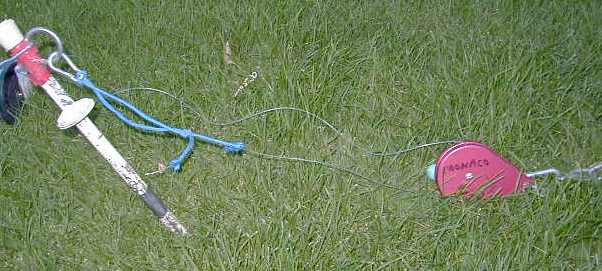
Pulley and Stake. Safety wires to the left are not pictured but they are there. Stake is not completely in the ground for this picture.
- Towing Equipment – the towing equipment consists of the ropes, handles, pulleys and shields and assorted attaching hardware.
- Straight tow – no pulley and no stake required. Towers pull directly on the end of the line. This is rarely used these days. It is occasionally used when the wind is particularly high and the lift is elusive to get a higher tow as the expense of time on line.
- Pulley Tow – This is the normal towing method
- 2 towers on a set of Y handles attached to a pulley pull the airplane up.
- The pulley must have a shield and lines of specific size. The shield must be 15cm in diameter – in the states we generally use a good quality Frisbee as the shield. The cheap Frisbees tend to shatter when hit or cracked. The line/rope must be at least 5mm in diameter and the legs of the Y must be between 1.5 and 3m long.
- Pulleys can be ordered at www.skipmillermodels.com
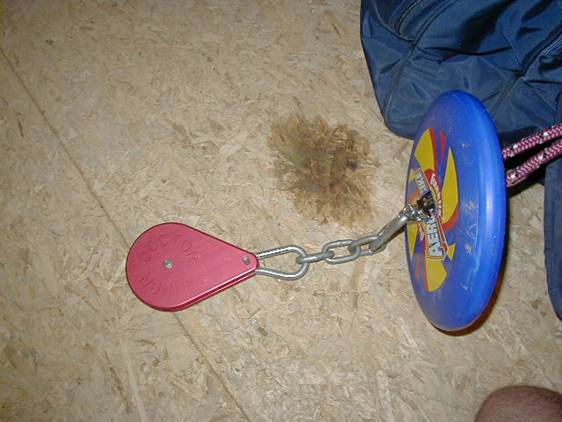
Close-up of Pulley and shield. Note there is an optional small pulley on the carabiner to allow the rope to slide. This is not required.
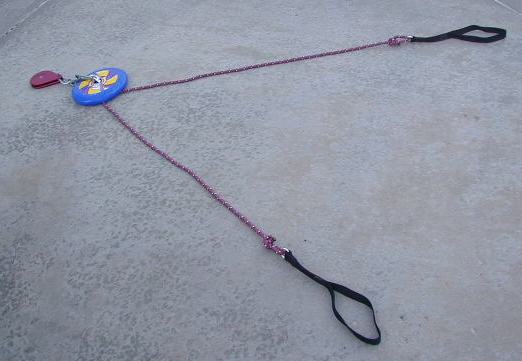
Tow Rig - I also now use padded kite handles from “into the Wind”.
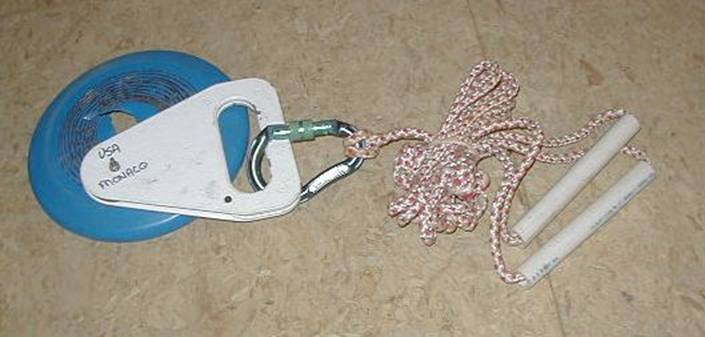
A different Pulley Setup - This is a Fredette pulley with PVC handles. Not as good as the kite handles.
- Line Reels – these are basically required when the event requires you to lay down and pick up your lines for every round. For the Normal US event the lines are left on the field and thus you only need to lay down and pick up at the end of the day. An electrical cord reel is sufficient for these events.
- Used to store, lay down and take up the launch lines.
- Highly geared for speed.
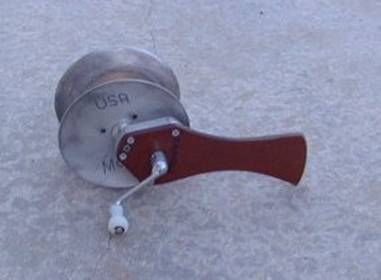
A Line Winder Great for quick retrieval of the line
- Tow Line – this is a stretchy monofilament line. The most popular is speedline from EMC-Vega in Germany. It can be ordered in the US from www.skipmillermodels.comin various sizes. Normally it is stored in water for at least 2 weeks prior to use to make it stretchier. Some have advocated various additives in the water as well, but I think the general consensus is that water soaking is fine.
- Monofilament line
- There are varying sizes for different conditions and aircraft
- 1.25 – no/light wind and light A/C
- 1.35 – general purpose moderate wind
- 1.45 – Big wind and Heavy models
- Sheathing is used to protect the line at connection points (both ends of the line)
- You can find this in climbing stores or good hardware stores. Some use parachute cord, or in the climbing stores it is known as accessory or utility cord. The 3mm or 4mm works well depending on the size of your mono.
- Use the outer sheathing on the ends of the mono where you attach things
- Use a lighter or soldering iron to melt the ends of the sheathing to prevent fraying. Just a touch is needed – you don’t want sharp hard edges.
- Cut and remove the inner lines from a 12-18” piece of sheathing and thread the end of the mono through it.
- Protects the line ends from damage
- Tie your knots in an overhand knot and avoid line overlaps.
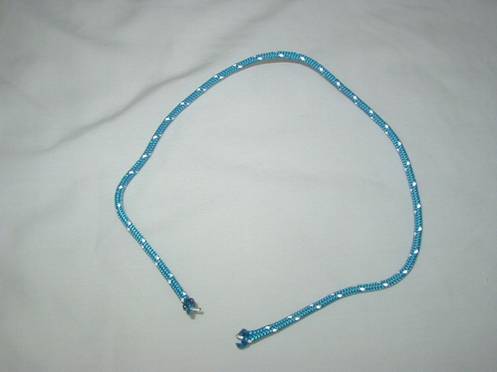
Sheathing
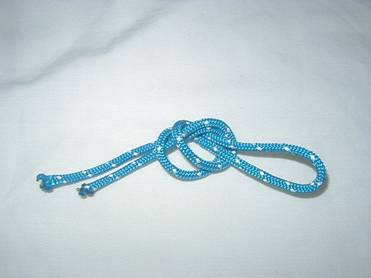
Sheathing showing knot
- Assorted accessories – there are various other items necessary to connect the lines and parts, and operate efficiently:
- Parachutes – use good ones with good rings. Parachutes or pennants are required. There are advanced methods of using parachutes without rings and they are just along for the ride – giving one less failure point.
- Carabineers
- Whistles
- Watches – watch management is a key to good teamwork and success. You should have a watch to monitor the prep and working time as well as keep track of the flight time.
- Usually each team uses 2 watches during each flight – different colors and even watch styles is helpful to ensure that you don’t mix up the watches and count down on the wrong one – trust me – it happens…
- Usually we use the countdown watch for the prep/working time and a count up watch for the flight time.
- Get all the equipment laid out and organized
- Set the lines out so the launch end of the lines is several steps in front of the launch area
- This is so that when you are preparing to launch you can walk back into the launch area and get proper tension on the line.
- Set out two lines of your choice so you have a primary and backup ready.
- No electronic communication devices allowed between pilots and tow men. No cell phones, walkie talkies etc.
- Hand signals used for all communications with towers. It helps to have a whistle available in case the tower are not paying attention. This is most helpful if there is an unexpected reflight in the middle or end of a flight. The towers are winding down then and you may need to get their attention.
- There are several important signals that are used to communicate with the towers. While these are not always the hand signals that are used they are commonly used, you can choose to invent your own if you like…:
- Get ready to tow – windmill arm motion
- Select line to use – left or right L shape arms – tower repeats to confirm
- More tension – pumping arm up and down
- RUN – Leg kick
Procedures – Setup
Signals
A few important details about signals. Always be clear to the towers WHO is going to give signals, especially the kick. There is a lot of activity at the flight line and they can’t watch everyone. Usually the pilot does the kick and the rest of the signals, so he should stand in a consistent place, generally behind and to the left or right of the thrower. When choosing the line, use the L shaped arms to indicate which line you want to launch on, and expect a confirmation from the towers so you know everyone is on the same page. Occasionally the towers will respond with a signal different than the one you gave. If this occurs, give your signal again. If the tower again responds with a different signal, he is telling you that you should NOT launch on the line you want. This is probably because they have found a problem with that line. In that case repeat the signal for the other line and expect a confirming signal back, then fly on the alternate line.
Launching
- Set the watches properly
- Zero the flight time watch
- Set the Window watch to the Window time PLUS the prep time. For example, for a 10 minute window and a 5 minute prep time set the watch to 15 minutes. For a 10 minute window with a 1 minute prep – set the watch to 11 minutes.
- Listen for the countdown to the beginning of the PREP time and start the working time watch. This now lets you keep track of the prep time and be ready to launch when the watch is at 10 minutes. (note that the organizer announcements will also count down to the start of the working time. This just helps you be ready.)
- During the prep time signal the towers what line to use and pretension the line
- With 10 seconds left to the start of the working time, the launcher does final tensioning of the line and moves into the launch area.
- Depending on tension the pilot kicks 0-2 seconds prior to the horn. DO NOT KICK SO SOON THAT THE THROWER CANNOT HOLD UNTIL THE BUZZER! The thrower should tell the pilot when he wants him to kick. If there is a lot of tension, he may want a 1 second kick, or on the buzzer, but if the tension is low the thrower may want a 2 or 3 second kick.
- After hearing the launch tone the plane is thrown hard.
- Stay in your Lane – weaving around is a bad thing. Don’t tension as much if you are launching wild.
- When the plane comes off the line – start the flight watch
- If the line breaks during the launch
- If you can fly it out – make it happen – this means a very good score if you make it.
- If you have no hope, then IMMEDIATELY turn to land.
- Be sure to land or catch the plane OUTSIDE the safety area
- Your helper should be resetting the watch, signaling the towers to switch to the second line and getting the end of the 2nd launch line ready for the relite.
- The helper will hook the plane up and run back to tension and holler to the pilot when he is ready to throw. The pilot then kicks to start the 2nd launch.
During the Flight
- Just like regular TD – keep track of other pilots and time left
- Estimate your ability to make the 10 – if things are bad – you may want to bail and relite, rather than wasting time on a fruitless effort.
- Be sure to reset the FLIGHT watch on a relite – leave the window watch running
- Once you commit to a relite – that flight counts
- Pay attention to other pilots that relight – estimate their max remaining time
- Important because if everyone is falling out, the first to relite and get to lift can be the winner
- If the first relite can get only 7 minutes, if everyone else relites, you can win with a 7:01 flight
- Once you pass 5 minutes, you will probably NOT relite
- The exception is if you land out. This would be a zero flight, but if there is still time on the clock you can relite your backup plane and get a few minutes of time for the flight.
Landing
Plan your landing – everyone comes in at the same time so there is not a lot of room to maneuver.
- Many people like the long straight in approach
- If running a pattern be sure to look around for traffic – timer should help with directions and traffic
- Be flexible
- No skegs allowed so higher approaches and dorks are required.
- Slides suck!
Have Fun!!!